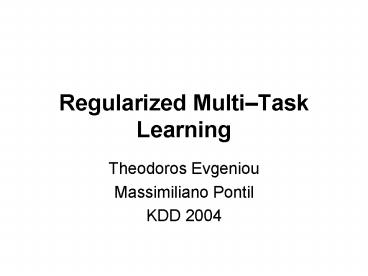Regularized MultiTask Learning - PowerPoint PPT Presentation
Regularized MultiTask Learning
Regularized Multi Task Learning. Theodoros Evgeniou. Massimiliano Pontil. KDD 2004 ... Obtain a better estimation of common part of the tasks. ... – PowerPoint PPT presentation
Title: Regularized MultiTask Learning
1
Regularized MultiTask Learning
- Theodoros Evgeniou
- Massimiliano Pontil
- KDD 2004
2
Multi-Task Learning
- Learn many related tasks simultaneously
- Tasks have commonality
- Each tasks have their specialty
- Why multi-task learning (my understanding)
- Obtain a better estimation of common part of the
tasks. - Acquire better understanding of the problems and
their underlying model - Application
- finance forecasting models
3
SVM A Brief Introduction
4
Regularized MultiTask Learning
- Based on SVM classifier
- Learn T tasks together, each task corresponds to
an SVM classifier - w0 carry information of the commonality
- vt carry information of the specialty
- Regularizing between commonality and specialty
when solving the problem
5
Notation and Setup
- All data for the tasks come from the same space X
Y. (X ? Rd ,Y ? R). - T1 corresponding to single task problem
6
Problem Formulation (Primal)
If this is big, we will force vt to be small,
therefore emphases w0
If this is big, we force w0 to be small, therfore
emphases vt
7
Reformulate The Problem (Primal)
Proved by inspecting the Lagrangian Function of
(2). Weighted Means of wt
8
The Dual Formulation
- Using feature map reduce the problem to a
single task problem
The same discriminant problem for each tasks
The same optimization objective
9
The Dual Formulation (cont.)
10
Training Time
- Using a standard SVM to train
- O(number of training data3) O(m3)
- T tasks, each have m training example
- Training each task individually O(Tm3)
- Training all tasks together O(T3m3)
11
Experiment on Synthetic Data
12
Experiment on Real Data
PowerShow.com is a leading presentation sharing website. It has millions of presentations already uploaded and available with 1,000s more being uploaded by its users every day. Whatever your area of interest, here you’ll be able to find and view presentations you’ll love and possibly download. And, best of all, it is completely free and easy to use.
You might even have a presentation you’d like to share with others. If so, just upload it to PowerShow.com. We’ll convert it to an HTML5 slideshow that includes all the media types you’ve already added: audio, video, music, pictures, animations and transition effects. Then you can share it with your target audience as well as PowerShow.com’s millions of monthly visitors. And, again, it’s all free.
About the Developers
PowerShow.com is brought to you by CrystalGraphics, the award-winning developer and market-leading publisher of rich-media enhancement products for presentations. Our product offerings include millions of PowerPoint templates, diagrams, animated 3D characters and more.































